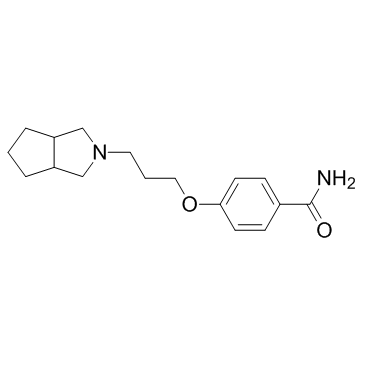| Cas No.: | 862896-30-8 |
| Chemical Name: | S38093 free base |
| Synonyms: | S38093 free base; S-38093; S 38093; |
| SMILES: | C1=C(OCCCN2CC3CCCC3C2)C=CC(C(=O)N)=C1 |
| Formula: | C17H24N2O2 |
| M.Wt: | 288.39 |
| Purity: | >98% |
| Sotrage: | 2 years -20°C Powder, 2 weeks 4°C in DMSO, 6 months -80°C in DMSO |
| Description: | S 38093 is a brain-penetrant antagonist of H3 receptor, with Ki of 8.8, 1.44 and 1.2 µM for rat, mouse and human H3 receptors, respectively. |
| Target: | Ki: 8.8 µM (Rat H3 receptor), 1.44 µM (Mouse H3 receptor), 1.2 µM (Human H3 receptor)[2] |
| In Vivo: | S 38093 (0.3 and 3 mg/kg/d p.o., 28 days) significantly increases proliferation of progenitors in the DG of hippocampus in young adult mice. S 38093 (0.3 mg/kg/d) treatment significantly increases the number of DCX+ cells with tertiary dendrites. S 38093 (0.3, 1 and/or 3 mg/kg) significantly increases cell proliferation, survival, and maturation in the DG of hippocampus in aged mice relative to vehicle. S 38093 (3 mg/kg/d p.o., 28 days) increases cell proliferation and has a strong effect on cell survival, also increases the dendritic intersections in both genotypes (one-way ANOVA with repeated measure, p < 0.01), with a significant effect from 50 to 80 in APPSWETG mice only. In aged mice, chronic administration of S 38093 (1 and/or 3 mg/kg/day p.o., 28 days) reverses this age-dependent decrease in BDNF-IX, BDNF-IV and BDNF-I transcripts. In addition, S 38093 at three tested doses (0.3, 1 and 3 mg/kg/d) increases VEGF transcripts compared to vehicle-aged group[1]. In mice, S 38093 significantly increases ex vivo N-tele-Methylhistamine cerebral levels from 3 mg/kg p.o. and antagonized R-α-Methylhistamine-induced dipsogenia from 10 mg/kg i.p[2]. |
| In Vitro: | In cellular models, S 38093 is able to antagonize mice H3 receptors (KB=0.65 µM) and to suppress cAMP decrease induced by an H3 agonist via human H3 receptors (KB=0.11 µM). In cells expressing a high H3 density, S 38093 behaves as a moderate inverse agonist at rat and human H3 receptors (EC50=9 and 1.7 µM, respectively)[2]. |
| Animal Administration: | The context discrimination task consists of an 8-day contextual fear discrimination paradigm in which the mice have to learn to distinguish between a fearful shock context and a similar non-shock context. On day 1 the mice are only exposed to the training shock context, and on days 2-8 the mice are exposed to the shock and then non-shock context in that order each day. The mice are run through the context discrimination task starting at 10 am and ending at 2 pm and are then gavaged with vehicle or S 38093 at 4 pm each day. The drug and vehicle are always administered after behavioral testing to avoid possible acute effects of the drug on behavior. Learning is measured by the percent time the mice spent freezing and testing is terminated when percent freezing is consistently significantly different between the two contexts. The mice are tested after 29 days of drug treatment. Conditioning is conducted on one side of a Med-Associates shuttle box (ENV-010MC; 20.3 cm × 15.9 cm × 21.3 cm high) with a clear plexiglass wall, 3 aluminum walls and a stainless steel grid as a floor. Mouse behavior is recorded by digital video cameras mounted above the conditioning chamber. Freezeframe and Freezeview softwar are used for recording and analyzing freezing behavior, respectively. In training context A, mice are allowed to habituate in new cages outside the room and are then brought into the room in the new cages. The house fan and house light are turned on, the stainless steel grid is exposed, the plexiglass wall is up and a mild anise scent is used as an olfactory cue. The door to the sound dampening enclosure is shut for the duration of the trial. 180 s after the mice are placed in the training context, they are delivered a single footshock of 0.75 mA lasting 2 s. 15 s after the end of the footshock, the mice are placed back into their home cages. Non-alcoholic antiseptic wipes are used to clean the grids and catch trays in between trials. An hour later the mice are brought into the room in paper buckets and put into similar context B. The house fan and house light are turned off, the door of the enclosure is left ajar, plastic placemat sheets are put into the shuttle box to make a high-walled circular enclosure, the plexiglass wall is left down and a mild lemon scent is used as the olfactory cue. The stainless steel grid, a salient feature of both contexts, remained exposed. The mice stayed in the chambers for 180 s without receiving a footshock and are placed back into their home cages. 70% ethanol is used to clean the grids and catch trays between trials. The discrimination ratio allowed for evaluation of discrimination between the two contexts and is computed as follows: A = freezing in context A, B = freezing in context B, and the discrimination ratio = A/(A + B). Larger values indicate better discrimination. |
| References: | [1]. Guilloux JP, et al. S 38093, a histamine H3 antagonist/inverse agonist, promotes hippocampal neurogenesis and improves context discrimination task in aged mice. Sci Rep. 2017 Feb 20;7:42946. [2]. Sors A, et al. Mechanistic characterization of S 38093, a novel inverse agonist at histamine H3 receptors. Eur J Pharmacol. 2017 May 15;803:11-23 |

 DC Chemicals' products qualify for U.S. tariff exemptions. We guarantee no price increases due to customs duties and maintain stable supply, continuing to deliver reliable research solutions to our American clients.
DC Chemicals' products qualify for U.S. tariff exemptions. We guarantee no price increases due to customs duties and maintain stable supply, continuing to deliver reliable research solutions to our American clients.





















